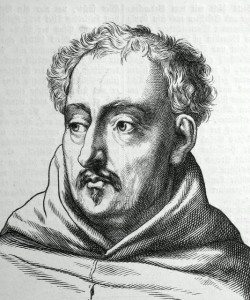As we work our way through the ten steps of the How To Practice Zen program, we will gradually begin to understand what the Augustinian monk Abraham of Santa Clara meant when he said: “He who dies before he dies does not die when he dies.”
Abraham’s quote echoes the words of the Buddha: “All that arises is of the nature of falling. That which does not arise does not fall.”
Both Abraham of Santa Clara and the Buddha shared the same insight: Only an independent self can live and die; where there is no independent self, there is no thing that can come into existence and there is no thing that can go out of existence.
If during our lifetime we can drop the notion of an independent self, and all the desires that belief creates, our ignorance dies and we are free. We understand that there is no independent self created at birth, and no independent self capable of leaving awareness when a body dies. We understand that the body is a mind object and that it comes and goes like all other mind objects.
However, we use the word “understand” with a caveat. The fundamental Buddhist doctrine of no self cannot be understood with a thinking mind. This “understanding” becomes clear in deep meditation. When we have sat by The Still Forest Pool for a long time, the jhanas arrive and we understand.
When we experience the jhanas, we leave the world of desire, the six worlds mentioned in Master Hakuin’s chant, and we arrive in the world of form. When we leave the jhanas and enter into the immaterial attainments, then we make it to the world of formlessness. Nirvana is even beyond that.
Amazingly to those of us who are still mired in the world of desire, one of the ten fetters that bind us to this desire realm is the desire to leave the world of form and to enter the world of formlessness! That is one of the higher fetters, experienced only by those in the neighborhood of Nirvana.
When we drop our desires and opinions, we have abandoned mortal thoughts of life and death. We wake up and realize that there is no independent self created at birth and destroyed at death. This is the truth of which the Bodhisattva known as the Christ spoke when he said there was a truth that would set us free.
When he said: “I and the father are one,” he was putting into words what he had realized, what all awakened sentient beings realize when they wake up. “I and the father are one” is just another way of saying: “All living beings are truly enlightened and shine with wisdom and virtue.”
It’s also another way of stating the ultimate truth: Anatta. No self. No separate self independent of everything else.
It is easy to understand how people who heard the Christ say those words could easily interpret them as being exclusive to him and to him alone. It is not surprising that they failed to understand the deeper import of what he was saying, and that they began worshipping him, trapped in their own delusions and lack of understanding.
If the Christ had said: “Wonder of wonders! I just realized that we humans and god are not separated from each other at all; in fact, we are one!” then he would not have been put up on a pedestal as the one and only human being that had become one with a god.
The Buddha, at the moment of his awakening, said the same thing that the Christ said at the moment of his awakening. The Buddha made it clear that he was a human being who had awakened; the Christ used words, perhaps put into his mouth by Paul, that led many to believe that he was not one of us. The Buddha made it clear that he was one of us. In Buddhism, the Buddha is respected or venerated, but he is not worshipped.
The Buddha does not own the truth, any more than the Christ or Abraham of Santa Clara. The truth just is. Those few who have experienced a truth that is beyond words experience difficulty in explaining what they have found to others. The others become their followers, their followers worship them or their words, and after a few generations their deep insight gets watered down to a few orthodox beliefs. The bath water remains, the baby is gone.
Zen Buddhism provides a practice that leads to the awakening of which Jesus the Christ spoke. Rote prayer (Lord, thank you for this day and its many blessings; be with the sick and afflicted, guide, guard and direct us for in Jesus’ name we pray, Amen) does not lead to awakening. Blind belief in a god, a savior, or a prophet does not lead to awakening. Singing songs in a church building, listening to sermons, and putting money in collection baskets do not lead to awakening.
Awakening requires active work. Buddhism lays out a daily path of practice that is active work and that leads to awakening.
Paradoxically, striving to awake never works. Enlightenment cannot be grasped or attacked. All we can do is create the conditions for awakening to occur. An authentic daily Zen practice creates those conditions.
If we were chained to the floor of a dungeon and were offered a trip to the top of the castle, we would take it. Once there, admiring the view of the valley, the river, the mountains and lakes, breathing the fresh air, hearing babbling brooks and the songs of birds, we would not choose to return to the dungeon if given the choice.
However, the point of Zen practice is not to lift us from a dark place into the light. That’s what self-help or self-improvement programs try to do.
The point of Zen practice is to enable us to see, to experience the fact that the dungeon/death and the top of the castle/life are mind alone. The dance of life and death is a creation of mind. Remember Dogen’s words.
An enlightened mind is neither enslaved nor liberated. The middle way is neither up nor down, neither happy nor sad. Nor is it a bland nothingness; it is a fullness, a wakefulness beyond mere joy or bliss. One experiences bliss upon entering into that state beyond bliss and one experiences bliss again upon re-entering the mundane world.
Only the awakened reside in that state of Incomprehensible and Incomparable Enlightenment. Awakening happens when it happens. It cannot be forced to happen. We cannot practice Zen so that we can win enlightenment. We can only practice Zen with diligence every day to create the conditions that allow awakening to occur.
We do not practice Zen to save ourselves from some vengeful, angry god who gets so mad that steam comes out of his ears. We do not practice Zen to gain entry into some man-made vision of a Billy Graham heaven where the golf courses are really nice. We practice Zen to allow our original, undefiled self to awaken. If we practice Zen with diligence, we learn who or what we are. The bottom of the bucket falls out, and we awaken to a reality that has always been there but which no one can describe.
When a person awakens, that is the Second Coming. It comes unexpected like a thief in the night. When a person awakens, that person realizes that life and death, gods and devils, right and wrong, and every other dichotomy, are illusions created by the unenlightened mind.

